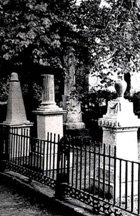
Click here to download a PDF version of this document.
The Old Chapel Hill Cemetery
Est. 1798
Chapel Hill, North Carolina
History of the Cemetery
The Old Chapel Hill Cemetery lies in the heart of Chapel Hill, North Carolina. The site was part of a land grant given by the State of North Carolina in 1796 to develop the University of North Carolina, and the cemetery originally served as a final resting place for University faculty and students.
The University’s Dialectic and Philanthropic Societies were the first to establish burial plots. The earliest recorded burial, in 1798, was that of 19 year old George Clarke, although the stone marking his grave dates from the mid-19th century. Several monuments in the Di and Phi enclosures are the work of noted 19th century stonecarver George Lauder of Fayetteville. Other monuments were carved by British stonemasons originally hired to construct Raleigh’s state capitol in 1840. The Cemetery was enclosed in 1835 by a rock wall, constructed at a cost of $64.41.
Dr. Joseph Caldwell, the first person officially titled President of the University of North Carolina, was interred here in 1835, but in 1846 was removed to a monument erected on McCorkle Place on the main campus. At that time, University trustees proposed creating a new cemetery on McCorkle Place, but this did not come to fruition. Instead, the trustees officially changed the name of the old cemetery to the “College Graveyard”, but it continued to be called the “Village Cemetery” by most residents.
There were no black church cemeteries in Chapel Hill in the 18th and early 19th centuries; consequently, the slaves of the village were buried in a segregated section of the Cemetery (Sections A and B), separated from the other sections (I, II, III and IV) by a low rock wall, which still stands. The large sandstone obelisk in Section B, dedicated to the black servants of the University, is the original Joseph Caldwell monument from McCorkle Place, which was replaced in the late 19th century by a granite obelisk. Many of the fieldstones in Section A and B mark the graves of unknown blacks.
The Cemetery was used for the interment of many administrators, professors and teachers of the University, as well as public officials, prominent businesspeople, and local authors, artists and entertainers. During the Civil War, many Confederate soldiers, their graves marked by “C.S.A.” stones, were buried here. Veterans of later wars also are at rest here.
The Cemetery was expanded to its present boundaries in 1928. Although it is now nearly full, burials still occur in all six sections. In 1922, the University and the Town of Chapel Hill entered into an agreement for the Town to maintain the Cemetery and administer the sale of lots, but it was not until 1988 that the University officially deeded the Cemetery to the Town.
The Old Chapel Hill Cemetery represents the broad spectrum of people who helped found Chapel Hill and its University, and who gave it a unique place in North Carolina history.
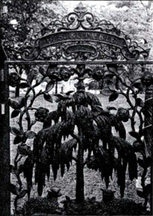
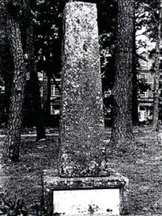
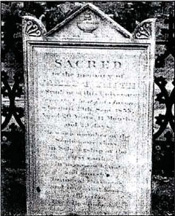
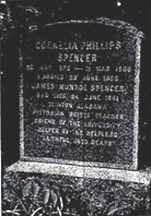
Some Graves in the Cemetery
Please refer to the map for locations.
Section A
- E04.
- Charlotte Hargrave, 1847-1924. A nurse for 50 years.
- F02.
- Fannie McDade, 1861-1964. Laundress for students; died at age 103.
- G17.
- Annie Harton, 1843-?. Example of “home-made” concrete stone.
- G25.
- Nellie Strowd Strayhorn, 1850-1950. Died at the age of 100.
- H37.
- Thomas Booth, Sr., 1887-1955. Stone and brick mason; with brother Lewis, built some stone walls on campus and some houses on Gimghoul Road.
- I04.
- George Kirkland, 1899-1948. First black dentist in Chapel Hill.
- I05.
- Dovard O’Kelly, 1888-1945. Ran dry cleaning plant for UNC and the town in 1920’s-30’s.
- I33.
- Rev. Lewis H. Hackney, 1854-1937. Pastor, Rock Hill Baptist Church (now First Baptist) for 60 years.
- J19.
- Jesse Jones, 1858-1912. Well-known chef at Pickard Hotel. Later ran The Coop, a popular student eatery located behind Ackland Art Museum.
- K05.
- Henry Merrett (Merritt), 1871-1943. Long-time employee of Kappa Sigma Fraternity.
Section B
- 02.
- George Trice, 1838-1915. Ran oyster restaurant and shoe repair shop on Franklin Street.
- M34.
- Nannie Weaver, 1871-1971. Died at the age of 100.
- N33.
- Dr. Edwin Caldwell, 1867-1932. Son of Wilson Caldwell (S26). Received medical degree at Shaw U. in Raleigh; practiced many years in Chapel Hill. Developed cure for pellagra.
- R19.
- George Barbee, mid-19th century. One of the oldest stones in this section.
- R24.
- Elington Burnett, ?-1853? Another very early stone.
- S26.
- Wilson Swain Caldwell, ?-1898. Monument originally located on campus for Dr. Joseph Caldwell. Ex-slave; established first school for blacks in Chapel Hill; Town Commissioner in 1880’s. Others honored at this monument are father November Caldwell, David Barham, and Henry Smith.
- Y09.
- Dilsey Craig, 1802-1894. A slave for over 60 years in the home of the prominent Phillips family (see Section I).
Section I
- BB0l.
- Jane Tenney Gilbert, 1896-1980. Epitaph reads:"I was a Tar Heel born and a Tar Heel bred/and here I lie a Tar Heel dead./Born Jan. 1886 AND STILL HERE 1980."
- EE21-22.
- Confederate soldiers’ markers.
- GG16.
- Col. Hugh Blair Guthrie, 1814-1881. Mayor, skiff, postmaster, member of NC General Assembly. Unique chest tomb and inscription.
- GG20.
- John Husky, 1840-1920. Blacksmith.
- HH-II16.
- Tenney (Tenny) Family. Owners of Tenney Plantation off East Franklin Street in 19th century.
- II25.
- Foster Utley. 1820-1894. University carpenter during Reconstruction.
- JJ16.
- Thomas West Harris, 1839-1888. First Dean of Medical School; also ran drugstore.
- JJ18.
- Algernon Barbee, 1840-1918. Mayor.
- MM05.
- Louis Graves, 1883-2965. Founder, publisher and editor of Chapel Hill Weekly.
- MM08-RR19.
- Dialectic and Philanthropic Societies enclosures. During UNC’s early years, all students were required to join one of these societies. Interesting epitaphs; stones and fences are fine examples from the Victorian era.
- OO01.
- Ralph Henry Graves, 1878-1939. Reporter and editor for NY Post and NY Times; biographer of Henry Ford. Brother of Louis Graves.
- OO01.
- Mary Graves Rees, 1886-1950. Portrait painter and sketcher of Chapel Hill scenes. Sister of Louis and Ralph.
- OO08.
- Nancy Billiard, 1798-1873. Proprietor of Eagle Hotel, on present site of Graham Memorial Building, which President Polk once visited. She later built a home called the Crystal Palace, on present site of Planetarium Rose Garden, where she took in student boarders. Her parents are buried in two unmarked graves just to the north of hers.
- PP18.
- Graham Morrow, ?-1863. Killed at Gettysburg. A brother was killed at Fredericksburg, and another in Atlanta.
- PP19.
- Edward and Annabella Martin, mid-19th century. Young wife died 3 days after marriage; romantic epitaph.
- PP29.
- (Charles) Dale Beers, 1901-1976. Prof. of Zoology.
- PP29.
- Alma Holland Beers, 1892-1974. Long-time assistant to Botany Prof. William Coker.
- QQ13.
- Sophia MacNider, 1846-1929. Ran boardinghouse and prep school in home at Franklin and Henderson Streets.
- QQ13.
- William MacNider, 1881-1951. Dean of Medical School; authority on kidney diseases and aging process.
- QQl5.
- Edward Mallett, 1827-1865. Killed at Battle of Bentonville; buried in his bloody uniform.
- RR11.
- George Clarke, 1779-1798. First known interment in cemetery; stone dates from mid-19th century.
- RR12.
- William Mallett, 1819-1889. Physician; ran student infirmary. Also had chemist’s shop and post office in home at Franklin and Henderson Streets.
- RR16.
- Edward Kidder Graham, 1876-1918. UNC President 1914-18; advocate of women’s rights; died in influenza epidemic.
- RR02, SS01-03-04.
- Phillips family. Prominent Chapel Hillians. Charles (1822-1889) was UNC Professor; his daughter Cornelia Phillips Spencer (1825-1908) helped reopen UNC during Reconstruction; his son Samuel (1824-1903) was Prof. of Law, and later U.S. Solicitor General under President Grant.
- 006.
- Walter Toy, l854-1933. Prof. of Modern Languages for 48 years.
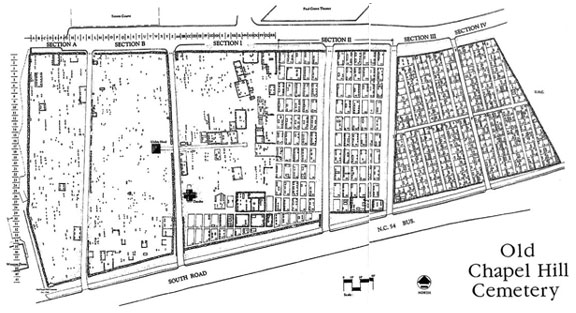
Section II
- 001.
- Collier Cobb Sr., 1862-1934. Prof. of Geology for 42 years.
- 001.
- Collier Cobb Jr., 1893-1982. Founder, Collier Cobb Insurance.
- 002.
- Harriet Morehead Berry, 1877-1940. Advocated North Carolina road improvements; section of I-40 between Durham and Hillsborough named for her.
- 007.
- William Meade Prince, 1893-1951. Artist and writer:“The Southern Part of Heaven”.
- 007.
- Lillian Hughes Prince, 1893-1962. Actress; First Queen Elizabeth in “The Lost Colony”.
- 008.
- Thomas Wilson, Jr., 1874-1945. Prof. of Greek and Latin; Registrar for 46 years.
- 008.
- Thomas Wilson (III), 1902-1969. Director of UNC Press and Harvard Press.
- 009.
- H.H. “Hoot” Patterson, 1844-1917. Ran general store on Franklin St.. First homeowner in Chapel Hill to install running water.
- 018.
- Gustave Braune, 1872-1930. First Dean, School of Engineering.
- 024.
- Louis Round Wilson, 1876-1979. Professor, librarian and historian. Wilson Library named after him.
- 025.
- Clyde Eubanks, 1871-1965. Druggist, bank executive, co-founder of Merchant’s Assn., alderman for 25 years.
- 028.
- William Coker, 1872-1953. Prof. of Botany for whom campus arboretum is named.
- 028.
- Francis Venable, 1856-1934. University President; Kenan Professor; served on UNC faculty for 50 years.
- 032.
- Robert Strowd, 1864-1934. Owned 1200 acre plantation in Davie Circle area off E. Franklin St. in early 20th century; built Strowd Block on W. Franklin St.
- 032.
- William Strowd, 1832-1911. Ran sawmill on Bolin Creek.
- 033.
- Alfred Engstrom, 1907-1990. Prof. of Romance Languages.
- 034.
- Eric Abernathy, 1876-1933. University physician for whom Abernethy Hall is named.
- 042.
- Bruce Strowd, 1892-1955. Owned Ford dealership at corner of Columbia and Franklin Streets for many years.
- 071.
- Estelle Lawson Page, 1907-1983. World champion golfer.
- 075.
- Joseph Hyde Pratt, 1870-1942. Prof. of Geology and first chairman of Planning Board.
- 075.
- Mary Bayley Pratt, 1874-1929. First Chapel Hill public library named for her.
- 086.
- Isaac Prichard, 1853-1935. State representative; director, Bank of Chapel Hill; developer, Westwood subdivision.
- 087.
- William Pritchard, 1850-1930. Storekeeper, postmaster, mayor, state senator. Until his death, ran 15 acre farm west of Columbia St. near present Town Hall.
- 088.
- Foy Roberson, M.D., 1884-1955. Chief of surgery, Watts Hospital. Established Foy Roberson Jr. (1918-1941) basketball award.
- 092.
- Marvin Hendrix Stacy, 1877-1919. Served 3 months as acting UNC President; died in same influenza epidemic that took the life of his predecessor, Edward Kidder Graham.
- 092.
- Inez Koonce Stacy, 1886-1961. Advisor of Women and Dean of Women, 1919-1946.
- 098.
- A.B. Roberson, M.D., 1840-1897. Physician, druggist, hotel owner. Owned 1500 acre farm east of town.
- 098.
- William Roberson, 1869-1935. 3-time mayor, teacher, realtor, lawyer.
- 100-110.
- Carmichael Family. Prominent businesspeople and UNC supporters. Carmichael Gym named for William, Jr. (1900-1961), Acting UNC President.
- 102.
- Zeb Council, 1876-1958. Mayor.
- 107.
- Mid-19th century obelisk marking graves of children in Elisha Mitchell family, originally interred behind his home (currently the site of a parking lot behind Swain Hall). Mitchell was Prof. of Geology; Mt. Mitchell named for him.
- 107.
- Horace Williams, 1858-1940. Prof. of Philosophy. Left entire estate to UNC, including home on E. Rosemary and 1000 acres on present site of municipal airport.
- 129.
- Robert Foister, 1888-1963. Owned Foister’s Cameras on Franklin St.
- 130.
- Adam Kluttz, 1857-1926. Ran well-known general store on Franklin St.
Section III
- A08.
- Albert Coates, 1896-1989. Founder, UNC Institute of Government.
- A12.
- Francis LeClair, 1884-1973. Botanist; landscape architect; designed Old Well and Planetarium rose garden.
- B03.
- Sidney Long, 1861-1928. Chief of Police and dairy farmer.
- B12.
- Ralph Trimble, 1899-1975. Prof. of Engineering; surveyed much of Chapel Hill.
- B15.
- James Street, 1903-1954. Novelist:“The Biscuit Eater”, “Good-bye, My Lady”.
- B21.
- Hiram Stone, 1856-1901. Blacksmith.
- C08.
- James Gooch, 1871-1940. Long-time owner of Gooch’s Cafe, Franklin St.
- C09.
- Oscar “Skipper” Coffin, 1887-1956. Prof. of Journalism; author.
- Dl4.
- Robert House, 1892-1987. UNC Chancellor, author.
- E08.
- Edwin Greenlaw, 1874-1931. Prof. of English.
- E11.
- Frederick (1893-1973) and Adeline (1900-1989) McCall. Two of the founders of North Carolina Symphony; he was UNC Prof. of Law; she composed score for “The Lost Colony”.
- E12.
- Frederick “Prof” Koch, 1877-1944. Founder, Playmakers Theatre.
- J06.
- Maurice Van Hecke, 1892-1963. Prof. of Law for whom Van Hecke-Wettach Hall is named.
- J15.
- Isaac Hall Manning. 1866-1946. Dean of Medical School, Kenan Prof. of Physiology. Founded Hospital Saving of N.C, providing first medical care in North Carolina for all its citizens, which became Blue Cross/Blue Shield.
- J16.
- John Taylor Manning, 1913-1982. Son of Isaac; attorney and judge.
- J21.
- Henry Brandis. 1609-1989. Dean of Law School.
- K11.
- James Tatum, 1913-1959. UNC football coach.
- K14.
- Edward Danziger, 1893-1972. Restaurateur (Viennese Candy Kitchen, Papa D’s); son started the Rathskeller.
- M04.
- James L Sutton, 1891-1950. Founded Sutton’s Drugstore on Franklin Street in 1923. Unique 'signature' inscription on stone.
- N02.
- Kay Kyser, 1905-1985. Famous bandleader.
- N14.
- John Nesbitt, 1860-1946. Engineer for 24 years on UNC railroad, the “Whooper”.
- N18.
- Braxton Lloyd, 1886-1947. County physician, mayor of Carrboro.
- O08.
- Carl Boettcher, 1886-1950. Woodcarver.
- O09.
- Mable Hill, 1893-1983. Silent movie pianist for many years at Pickwick Theatre on Franklin Street.
- O11.
- E. Carrington Smith, 1905-1977. Operated Carolina Movie Theatre.
- O12.
- Robert Connor, 1878-1950. Kenan Prof. of History; first United States Archivist.
Section IV
- F01.
- Fred Smith Sr., 1858-1939. Conductor for 48 years on UNC railroad, the “Whooper”.
- F10.
- Samuel Cornwell, 1925-1979. Prof. of Physical Education.
- F10.
- Paul Green, 1894-1981. Author and playwright:“In Abraham's Bosom”, and first outdoor drama, “The Lost Colony”.
- F12.
- English Bagby, 1891-1955. Prof. of Psychology.
- F13.
- Frank Porter Graham, 1886-1972. UNC President 1930-49, U.S. senator.
- G02.
- Rachel Crook, 1879-1951 (murdered). Ran Chapel Hill's first launderette; also ran fish/produce market which later became Crook’s Corner Restaurant.
- G15.
- Robert Coker, 1876-1967, Prof. of Biology and author.
- G17.
- Wesley Critz George, 1888-1982. Prof. of Anatomy; world-famous expert on study of blood and embryos.
- H05.
- Robert Wettach, 1891-1964. Prof. of Law for whom Van Hecke-Wettach Hall is named.
- H13.
- John Umstead, Jr., 1889-1968. State Representative.
- Q10.
- Edwin Lanier, 1901-1983. Mayor.
- Q17.
- Roy Armstrong, 1904-1984. UNC Dir. of Admissions; Dir. of Morehead Foundation; Brigadier General, US Army Reserves.
- Q18.
- Howard Odum, 1884-1954. Prof. of Sociology, founder of Institute for Research in Social Science, pioneer in study of black culture.
- R15.
- Robert Fowler, 1905-1961. Grocer; founded Model Market (later Fowler’s).
- R20.
- John Couch, 1896-1986. Prof. of Botany.
- S09.
- Dudley Carroll, 1885-1971. Dean, School of Business.
- S19.
- Walter Reece Berryhill, 1900-1979. Dean, School of Medicine.
- T06.
- Noel Houston, 1909-1958. Novelist and playwright.
- T11.
- Jeff Thomas, 1898-1957. Owner, Jeff’s Confectionery on Franklin Street.
- T14.
- Myrtle Etheridge, 1964-1990. Long-time telephone operator.
- T16.
- Henry Totten, 1892-1974. Professor of Botany, He and wife Addie (1889-1974) were well known horticulturalists for whom Totten Center at the NC Botanical Garden is named.
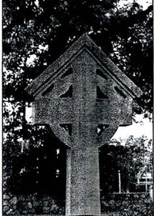
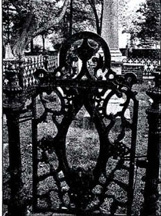
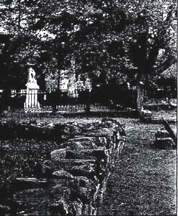
Produced jointly by the
Chapel Hill Preservation Society
and the
Town of Chapel Hill Bicentennial Committee
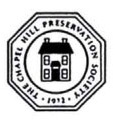
Chapel Hill Preservation Society
610 East Rosemary Street
Chapel Hill, NC 27514
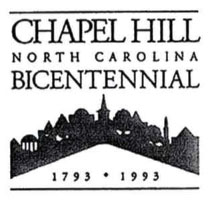
CAN WE HELP YOU? Are you interested in research or genealogy? Is one of your descendants buried here? If we can help you in your research, please contact us.
WILL YOU HELP US? Do you have information about anyone buried in the Old Chapel Hill Cemetery that you can share with us? We want to compile a history of the families into a permanent record.
We also need funds to help maintain our grounds and headstones.
To send us a donation, information, or a request for information please contact
Cemetery Fund
Town of Chapel Hill
306 N. Columbia Street
Chapel Hill, NC 27516
919/968-2796. Printed on recycled paper. Please recycle.





